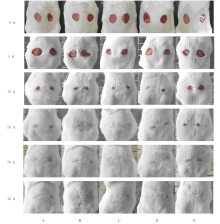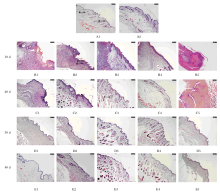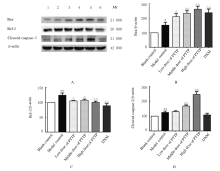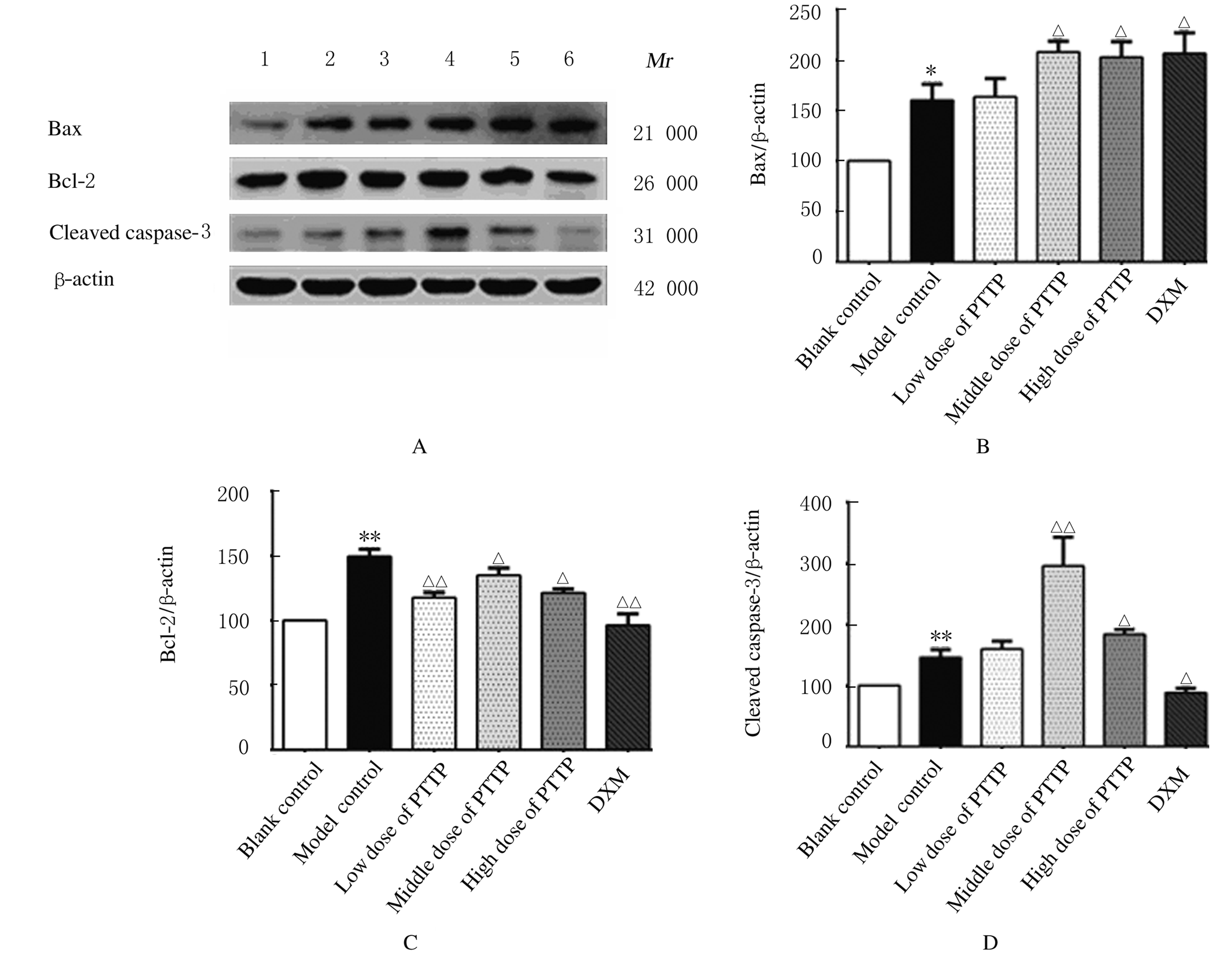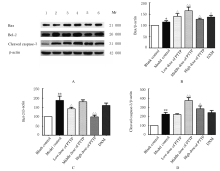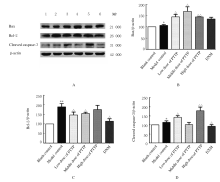Journal of Jilin University(Medicine Edition) ›› 2021, Vol. 47 ›› Issue (2): 265-274.doi: 10.13481/j.1671-587X.20210203
• Research in basic medicine • Previous Articles Next Articles
Inhibitory effect of prunus tomentosa thunb total flavonoids on skin hypertrophic scar in mice and its mechanism
Tianqi ZOU1,Lin BAI1,Zhengxu ZHANG1,He LI1,Chunmei WANG1,Jinghui SUN1,Jianguang CHEN1,Xi CHEN2( ),Chengyi ZHANG1(
),Chengyi ZHANG1( )
)
- 1.Department of Pharmacology,College of Pharmacy,Beihua University,Jilin 132013,China
2.Department of Etiology,College of Medical Sciences,Beihua University,Jilin 132013,China
-
Received:2020-07-30Online:2021-03-28Published:2021-03-25 -
Contact:Xi CHEN,Chengyi ZHANG E-mail:846617750@qq.com;zhchyjl@163.com
CLC Number:
- R285.5
Cite this article
Tianqi ZOU,Lin BAI,Zhengxu ZHANG,He LI,Chunmei WANG,Jinghui SUN,Jianguang CHEN,Xi CHEN,Chengyi ZHANG. Inhibitory effect of prunus tomentosa thunb total flavonoids on skin hypertrophic scar in mice and its mechanism[J].Journal of Jilin University(Medicine Edition), 2021, 47(2): 265-274.
share this article
Tab.2
Skin wound healing of mice in various groups (n=16,x±s,η/%)"
| Group | Healing rate of wound | |||||
|---|---|---|---|---|---|---|
| (t/d) 4 | 7 | 10 | 13 | |||
| Model control | 30.690±0.074 | 54.700±0.105 | 82.130±0.063 | 88.580±0.014 | ||
| DXM | 41.660±0.050** | 60.300±0.105 | 66.650±0.044* | 70.020±0.042** | ||
| PTTP | ||||||
| Low dose | 37.930±0.043* | 62.270±0.066 | 87.020±0.039* | 90.330±0.019* | ||
| Middle dose | 42.090±0.068* | 72.660±0.023* | 88.930±0.034* | 92.780±0.016* | ||
| High dose | 39.100±0.046* | 64.540±0.150 | 88.220±0.040 | 92.550±0.011** | ||
| Group | Healing rate of wound | |||||
| (t/d) 16 | 19 | 22 | 25 | |||
| Model control | 90.300±0.023 | 92.690±0.009 | 93.900±0.007 | 95.000±0.007 | ||
| DXM | 81.730±0.001* | 87.030±0.007* | 88.650±0.010* | 90.170±0.007* | ||
| PTTP | ||||||
| Low dose | 92.910±0.016* | 94.650±0.014 | 95.730±0.014 | 96.540±0.009* | ||
| Middle dose | 94.180±0.015* | 95.560±0.009** | 96.650±0.007* | 97.080±0.008* | ||
| High dose | 93.470±0.011 | 95.100±0.013* | 95.940±0.012* | 96.780±0.012 | ||
| Group | Healing rate of wound | |||||
| (t/d) 28 | 31 | 34 | 37 | 40 | ||
| Model control | 95.850±0.006 | 96.510±0.004 | 96.870±0.004 | 97.420±0.006 | 97.930±0.004 | |
| DXM | 91.180±0.009* | 91.960±0.009* | 93.410±0.003** | 94.380±0.007* | 95.580±0.004* | |
| PTTP | ||||||
| Low dose | 97.000±0.007* | 97.570±0.006 | 97.950±0.005* | 98.550±0.003* | 98.940±0.002* | |
| Middle dose | 97.500±0.005* | 98.040±0.002** | 98.560±0.002** | 98.900±0.001* | 99.140±0.002* | |
| High dose | 97.230±0.009 | 97.960±0.004** | 98.310±0.002* | 98.730±0.002** | 99.040±0.002* | |
| 1 | TAN W Q, FANG Q Q, SHEN X Z, et al. Angiotensin‐converting enzyme inhibitor works as a scar formation inhibitor by down‐regulating Smad and TGF‐β‐activated kinase 1 (TAK1) pathways in mice [J]. Br J Pharmacol, 2018, 175(22): 4239-4252. |
| 2 | ZHOU J ,ZHAO Y,SIMONENKO V, et al. Simultaneous silencing of TGF-β1 and COX-2 reduces human skin hypertrophic scar through activation of fibroblast apoptosis [J]. Oncotarget, 2017, 8(46): 80651-80665. |
| 3 | ZHOU Y, ZHAO Y, DU H, et al. Downregulation of CFTR is involved in the formation of hypertrophic scars [J]. Biomed Res Int,2020,2020:9526289. |
| 4 | ZHANG Y, SHAN S,WANG J, et al. Galangin inhibits hypertrophic scar formation via ALK5/Smad2/3 signaling pathway[J].Mol Cell Biochem,2016,413(1/2):109-118. |
| 5 | WANG H, GUO B, LIN S, et al. Apigenin inhibits growth and migration of fibroblasts by suppressing FAK signaling [J]. Aging(Albany NY), 2019, 11(11): 3668-3678. |
| 6 | 曹 爽, 范紫薇, 王映映, 等. 毛樱桃总黄酮对RAW264.7细胞中炎症因子水平的影响及其机制 [J]. 吉林大学学报(医学版), 2019, 45(4): 836-842. |
| 7 | BEER M F,FRANK F M,GERMĀN ELSO O, et al. Trypanocidal and leishmanicidal activities of flavonoids isolated from Stevia satureiifolia var. satureiifolia [J]. Pharm Biol, 2016, 54(10): 2188-2195. |
| 8 | 师继超, 赵东双, 刘圆圆, 等. 不同制备工艺所得毛樱桃总黄酮的抗炎活性研究 [J]. 北华大学学报(自然科学版), 2017, 18(3): 345-347. |
| 9 | PANG Y X, ZHANG Y,HUANG L Q, et al. Effects and mechanisms of total flavonoids from Blumea balsamifera (L.) DC. on skin wound in rats [J]. Int J Mol Sci, 2017,18(12): 2766-2767. |
| 10 | LV W F,DING M Y,ZHENG R. Isolation and quantitation of amygdalin in Apricot-kernel and Prunus Tomentosa Thunb. by HPLC with solid-phase extraction [J]. J Chromatogr Sci, 2005, 43(7): 383-387. |
| 11 | 穆 鑫. PLCε的缺陷延缓小鼠早期皮肤伤口愈合并减弱瘢痕形成 [D]. 天津:天津医科大学, 2017. |
| 12 | 赵冬双, 刘园园, 陈 曦, 等. 毛樱桃抗冻伤涂膜剂的制备及药效学研究 [J]. 中药材, 2018, 41(8): 1950-1953. |
| 13 | MA Y, LUO Y Q, SONG L, et al. Pharmaceutical screening of the effective fraction from Smilax for treatment of chronic pelvic inflammatory disease [J].Southern Med Univ, 2013, 33(1): 145-149. |
| 14 | ZHANG Y F, ZHOU S Z, CHENG X Y, et al. Baicalein attenuates hypertrophic scar formation via inhibition of the transforming growth factor-β/Smad2/3 signalling pathway [J]. Br J Dermatol, 2016, 174(1): 120-130. |
| 15 | SONG J, TRUONG D, YANG B. Quercetin shows the pharmacological activity to simultaneously downregulate the inflammatory and fibrotic responses to tissue injury in association with its ability to target multi-kinases [J]. Pharmacology, 2018, 102(3/4):142-153. |
| 16 | YANG L, LI X, ZHANG S, et al. Baicalein inhibits proliferation and collagen synthesis of mice fibroblast cell line NIH/3T3 by regulation of miR-9/insulin-like growth factor-1 axis [J]. Artif Cells Nanomed Birtechnol, 2019, 47(1): 3202-3211. |
| 17 | ZHANG M Z,DONG X H, GUAN E L, et al. A comparison of apoptosis levels in keloid tissue, physiological scars and normal skin [J]. Am J Transl Res, 2017, 9(12): 5548-5557. |
| 18 | SAFAEIAN L, ABED A, VASEGHI G. The role of Bcl-2 family proteins in pulmonary fibrosis [J]. Eur J Pharmacol, 2014, 74:281-289. |
| 19 | JIAN X Q,QU L,WANG Y L, et al. Trichostatin A-induced miR-30a-5p regulates apoptosis and proliferation of keloid fibroblasts via targeting BCL2[J]. Mol Med Rep, 2019,19(6):5251-5262. |
| 20 | 周 曙, 田 芳, 金海蓉,等. 姜黄素调节Bcl-2、Bax蛋白表达诱导增生性瘢痕成纤维细胞凋亡 [J]. 湖南中医药大学学报, 2015, 35(4): 6-9. |
| 21 | GONG Y F, ZHANG X M, YU J, et al. Effect of recombinant human endostatin on hypertrophic scar fibroblast apoptosis in a rabbit ear model [J]. Biomed Pharmacother, 2017, 91:680-686. |
| [1] | Xue LUAN,Guanghai YAN,Haibo LI,Bo ZHANG,Wei ZHANG,Yuanyuan HUANG. Effect of salidroside on airway inflammation in mice with asthma and its mechanism [J]. Journal of Jilin University(Medicine Edition), 2021, 47(3): 537-544. |
| [2] | Cuilan LIU,Jianjun LI,He JIANG,Jing LIU,Dan WANG,Chen LI,Di ZHAO. Effect of urolithin B on biological behaviors of human glioblastome U118 MG cells and its mechanism [J]. Journal of Jilin University(Medicine Edition), 2021, 47(3): 566-574. |
| [3] | Jia FENG,Haichan XU,Jian WEN,Zehua WU,Yi CHEN. Effect of betulinic acid on proliferation and apoptosis of myeloma cells by regulating JAK2/STAT3 signaling pathway and its mechanism [J]. Journal of Jilin University(Medicine Edition), 2021, 47(3): 615-622. |
| [4] | Pei GONG,Jingran LIU,Shimin ZHAO,Yuzhen WANG,Jiming XIE. Inhibitory effect of MCM10 silencing on proliferation of breast cancer MDA-MB-231 cells and its mechanism [J]. Journal of Jilin University(Medicine Edition), 2021, 47(3): 652-659. |
| [5] | Xiaohui LI,Ziwei QU,Xin LU,Qingbin MENG,Huatao CHEN,Jun REN,Chengpei TAN. Regulatory effect of exosomes carrying miR-196b-5p derived from bone marrow mesenchymal stem cells on biological characteristics of colon cancer cells [J]. Journal of Jilin University(Medicine Edition), 2021, 47(3): 660-668. |
| [6] | Bingxue QI,Yan MA,Yixian ZHANG,Yadong SUN,Lining MIAO. Effect of liraglutide on expressions of mRNA and protein of related proteins after podocyte injury induced by high glucose and its mechanism [J]. Journal of Jilin University(Medicine Edition), 2021, 47(2): 275-283. |
| [7] | Zhanqi ZHAO,Chengjin ZHANG,Juan TIAN. Inhibitory effect of Ndfip1 on ferrion-induced neuronal apoptosis and its neuroprotective mechanism [J]. Journal of Jilin University(Medicine Edition), 2021, 47(2): 338-343. |
| [8] | Haoxuan TANG,Nanfeng MENG,Meiling DU,Wei WANG,Tao HE. Inhibitory effect of new VEGF monoclonal antibody combined with all-trans retinoic acid on proliferation of breast cancer MCF-7 cells [J]. Journal of Jilin University(Medicine Edition), 2021, 47(2): 344-351. |
| [9] | Jie WU,Xuehua YANG,Ling MA,Wenqiang FAN,Dongdong FU,Xiao GAO,Shufei ZUO,Shu LIANG,Yilu QIN,Peishan WANG,Jinyan GUO. Effect of miR-26a-5p on apoptosis of human rheumatoid arthritis fibroblast-like synovial cells through JAK2/STAT3 signaling pathway [J]. Journal of Jilin University(Medicine Edition), 2021, 47(2): 460-468. |
| [10] | Haiying ZHANG,Wenxin ZHANG,Wenjing ZHAO,Wei LI. Induction effect of gallic acid on apoptosis of human hepatocellular carcinoma HepG-2 cells through regulating mitochondrial oxidative phosphorylation [J]. Journal of Jilin University(Medicine Edition), 2021, 47(1): 125-132. |
| [11] | . Inhibitory effect of curcumin on tumor growth in colorectal cancer mice and its mechanism of PTEN/PI3K/Akt signaling pathwayPEI Yongbin, WANG Guiqi, LI Wei, JIANG Xia, JIANG Haibo, ZHAO Zengren (Department of General Surgery,First Hospital,Hebei Medical University, Shijiazhuang 050031,China) [J]. Journal of Jilin University(Medicine Edition), 2021, 47(1): 145-151. |
| [12] | LI Qi, XU Rui, LI Tengteng, JIANG Yichuan, LI Min. Effect of pirarubicin on cardiomyocyte injury in rats and establishment of its model [J]. Journal of Jilin University(Medicine Edition), 2020, 46(05): 948-954. |
| [13] | LI Wei, ZHANG Haifeng, WANG Miao, HUO Jing, ZHANG Ying, ZHAO Cui. Protective effect of Astragalus Injection on heart of rats with sleep deprivation and its mechanism [J]. Journal of Jilin University(Medicine Edition), 2020, 46(05): 998-1003. |
| [14] | JIA Daqi, KONG Wencong, SU Rongjian, DU Xiaoyuan, HE Wubin. Effects of macrophage stimulating 1 receptor inhibitor BMS777607 on proliferation and apoptosis of lung cancer cells [J]. Journal of Jilin University(Medicine Edition), 2020, 46(04): 739-744. |
| [15] | ZHANG Shuangshuang, HE Wubin, SU Rongjian, DU Xiaoyuan. Effects of EZH2 inhibitor GSK126 on proliferation and apoptosis of lung adenocarcinoma cells [J]. Journal of Jilin University(Medicine Edition), 2020, 46(04): 786-791. |
